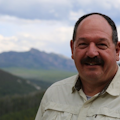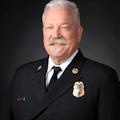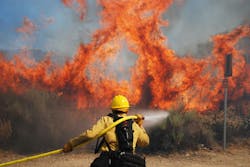Strategy & Preparation for Wildfires that Affect People and Structures
Strategy options that are available to an incident commander during a fire that’s in the interface often are determined by the critical factors that existed before the fire started and that have begun to affect people and structures that are in the interface.
Note: In this article, the terms “wildland structure interface” and “interface” indicate a condition where a fire in wildland fuels (i.e., grasses, brush, trees) affects structures, which affects communities, firefighters and fire departments.
Fire behavior, fuel and weather conditions
It is imperative for members to understand the local conditions that influence the behavior of a fire—in particular, fuel type and quantity, wind, aspect and slope, and the potential speed of growth (rate of spread) of the fire.
Members should study their local weather history, particularly wind speed, direction, and duration during the passage of cold fronts and other significant weather events. The effect of wind speed and direction of the spread of fires in the interface also is important to continuously observe and evaluate.
In the Northern Rockies, wind is a direct driver of fire behavior. Simply, the faster the wind speed, the faster that the fire moves and the more widespread the effect. In receptive fuels, wind speeds of faster than 10 mph drive fire in grass more quickly than firefighters who are on foot can suppress the fire. (Receptive fuels are grasses, brush and timber that are dry enough to burn: Hot, dry conditions result in hot, dry fuel. These fuels are referred to as receptive because when they are exposed to any form of ignition—lightning, sparks from human activity, flying, burning embers from an approaching fire front, etc.—they ignite readily. In comparison, fuels that are soaking wet are difficult to ignite, hence not receptive to ignition sources.)
In forested areas, winds that are faster than 20 mph can result in torching and intermittent crown fires. This development can produce an increase of embers that are cast to a distance of one-quarter mile to 1.5 miles ahead of the flaming front of the fire. The results of some research indicate that they are the cause of 90 percent of ignitions of structures that are affected by wildland fire.
At a basic level, slope has a similar effect on fire spread as wind speed has. The steeper the slope, the more quickly that the fire moves.
Aspect is the direction that the slope faces. It directly affects the preheat of fuels. The more that aspect is south and west, the more that the sun’s radiant energy preheats the fuel during the hottest part of the day. The greater the fuel preheat, the more quickly fire spreads.
Detailed mapping and address posting
Accurate recording of road names and addresses of structures on paper maps helps responders to navigate in a timely manner and provide room for notes about what responders will find, such as residents who are staying to defend their property and hazards that affect response.
An excellent example of mapping and preplanning for fires in the interface is the Wildland Fire Urban Interface Plan that’s used by the Hyalite Fire Department in Gallatin County, MT (hyalitefire.org/resources).
Deployment of firefighters
Fighting fire in the interface is a blend of both wildland and structure firefighting strategy and tactics. In all cases, it’s essential that firefighters who are at the task, tactical and strategic levels ensure that lookouts, communications, escape routes and safety zones (LCES) are in place and are utilized by every member who is deployed to the direct firefight.
Fires in the interface can benefit from firefighting actions that utilize a combination of wildland and structure firefighting equipment and skills. This level of skills and equipment allows firefighters the maximum amount of versatility in fighting fires.
Because some structures are arranged to have LCES in place, firefighters who are in the interface should have structure and wildland PPE, including SCBA, and apparatus that have fire-rated pumps and a standard complement of firefighting equipment. Engines that have a minimum of a 150-gpm fire-rated pump, a water tank that’s sized at a minimum of 500 gallons and four-wheel drive are effective in the interface.
How much help how quickly?
Mutual aid is vital, and it must be supported with command staff to manage the arriving help. Just as important is pre-incident planning, including prepackaged resource orders (standard greater alarms, command staff, strike teams, task forces, etc.).
Mapping and logistics must be in place to support continuous operation throughout the period of weather that favors fire spread as well as for several days afterward, to “patrol” communities to ensure that latent ignition is caught early.
The fire service in Montana has a strong mutual aid communications plan, and most of the fire agencies that are in the state have those channels in their radios. Many fire departments regularly practice command procedures using those radio channels.
Lots of response help can result in significant costs to a jurisdiction. Be ready with preapproval to authorize expenditures for resources (for example, mutual aid, helicopters, etc.) that exceed daily operations. Build understanding and support with the members of the governing bodies that set revenue and with finance staff that supports your organization.
Survivable structures
Fire protection for private property is overwhelmingly the responsibility of local government, although several states provide options for enhanced protection in response to wildland fires—in Montana, forest fire protection districts overlay private property.
Federal wildland firefighting agencies have no responsibility to protect structures that are located on private property.
Some state wildland firefighting agencies take a full-suppression approach to wildland fires and are strong, integrated mutual aid partners when it comes to the support of local fire departments regarding the protection of their community.
Local cooperators (of all kinds) are critical to successfully fighting fires in the interface.
Property owners who educate themselves, understand fire-resistive property maintenance and take action to make their property more resistive to the spread of fire likely will have better outcomes in the event that their property is affected by fire in the interface.
Individual responsibility of property owners/occupants includes the area from the home out to as far as several hundred feet, based on fuel load, slope, aspect and prevailing wind. Circumstances in which there has been a reduction of fuels that are around structures beginning at the structure and working outward are more likely to be resistive to fire spread than circumstances where a home has fuel closer to it.
Wildland Structure Interface Preparation To -Do List
1. Understand your local, historically accurate critical factors that are related to fires in the interface.
- Local weather in terms of wind speed, range and direction and occurrence of high winds
- Local fuel model that’s in your interface
- Various fuel and slope configurations and, particularly, what’s above the slopes (i.e., structures, people)
- Fire spread potential that’s based on fuels, wind, slope and aspect
- Potential risks to people and structures that are based on probable fire spread under historically realistic conditions of wind, slope and aspect
- Initiate, build and maintain operational relationships with other fire response, community and law enforcement organizations
2. Understand and rehearse risk management-based command decision-making using your organization’s risk management policy and procedure.
- Apply your agency’s risk management policy and procedure to probable fires in the interface in your community
- Practice command decision-making using preestablished strategic and operational plans, using the above listed critical factors and risk management policy and procedures during real-time simulations of interface fires in your community
- Include response partners in your command decision-making simulation training, particularly local law enforcement that has jurisdiction regarding evacuations and access control (and their mutual aid responders)
3. Develop and document response strategies based on your understanding of critical factors, risk management and needs of law enforcement responders.
- Update, share, and rehearse your strategic and operational plans, including with co-responders from law enforcement and other allied agencies
- Build mutual aid networks of other responders that are capable of putting firefighters and fire trucks on the ground within minutes and hours of your request; these are the most critical relationships that you can build to help to protect your community
4. Initiate the development of action plans that identify and preload support in the areas of community and media relations, liaison with allied responders, safety management, logistics, planning and finance.
- Initiate outreach to community members and organizations to help members of the community understand their individual responsibility to fulfill their critical, essential role in preparing their property and personal safety plans before a fire emergency strikes their home
- Initiate mutual understanding and support with your local government finance staff, which is critical to the recovery of the residents, the community and your organization
- Initiate and maintain understanding and support among local elected officials who regulate land use in your community; individual property owners’ responsibility for the readiness of their property can be addressed in local ordinances and development processes, rules and regulations
Videos & Other Wildland Fire Behavior Information
- It’s worth your while to acquaint yourself with the information about wind, slope and aspect in relation to wildland fire behavior that Doug Campbell, who is a wildland fire behavior scientist, provides here.
- Dr. Jack Cohen’s research on fire behavior and interaction between wildland fires and structures can be accessed at here and here.
- To view videos of fire spread by wind, slope and structure-to-structure ignition, go to Melody Lane Fire, Bridger Foothills Fire and Tunnel Fire Near Flagstaff, AZ.
- UL’s Fire Safety Research Institute has researched the effects of wind on fires in structures.
For overall excellence in addressing the risk to the community and to firefighters, contact Fire Chief Mark Gaillard of the Flagstaff, AZ, Fire Department, Fire Chief Brian Nickolay of the Hyalite Fire Department (Gallatin County, MT), Interim Fire Chief David Sprague of the Berkeley, CA, Fire Department and Sheriff Dan Springer of the Gallatin County, MT, Sheriff’s Office.
About the Author

Brian Crandell
Brian Crandell, Ed.D., is a 46-year student of the fire service. He has served as a firefighter, fire officer and chief of department. Crandell works with firefighters and fire departments across the United States to help members to develop effective coaching and leading skills.

John Culbertson
John Culbertson has been a responding command officer in Gallatin County, MT, for the past 23 years. He trains fire service personnel in wildland urban interface strategy and tactics and has responded to numerous interface fires in Montana. Culbertson is a shift command officer with Hyalite, MT, Fire Department and director of the Montana State University Fire Services Training School.

Mark Gaillard
Mark Gaillard, EFO, has been in the fire service since 1982. He serves as the fire chief of the Flagstaff, AZ, Fire Department and the Summit Fire and Medical District in Flagstaff, AZ. Gaillard has been active in the Arizona Fire Chiefs Association since 1986, supporting planning and professional development initiatives.
